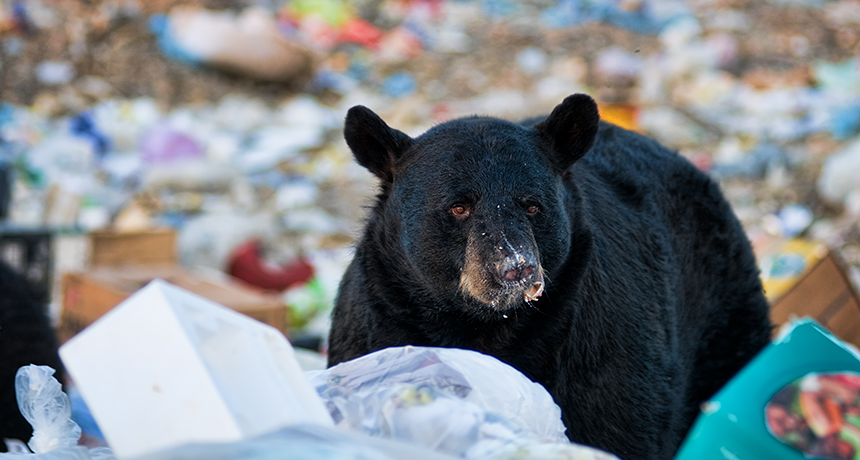Bears that eat human ‘junk food’ may hibernate less
And that might risk their aging faster at the cellular level, a study concludes

This black bear is finding food at a garbage dump. The more a black bear snacks like a human, the more likely that bear is to skimp on hibernation, a new study says. And shorter hibernation might accelerate aging at the cellular level.
sianc/iStock/Getty Images Plus
By Susan Milius
Mama bears may need to raise their snouts and join the chorus protesting junk food.
Bears are scavengers. And they’ll eat human food when it’s available. But in a new study, the more sugary, highly processed foods that 30 female black bears ate, the less time those bears were likely to spend hibernating. In turn, bears that hibernated less tended to score worse on a test for aging at the cellular level.
Researchers published the findings February 21 in Scientific Reports.
The new research grew out of an earlier project to see what wild black bears across Colorado were eating, says Jonathan Pauli. He’s a community ecologist at the University of Wisconsin–Madison.
While a Ph.D. student at the school, wildlife ecologist Rebecca Kirby checked diets from hundreds of bears across the state. Hunters there are not allowed to set out bear bait, such as heaps of doughnuts or candy. That means the animals’ exposure to human food comes mostly from scavenging.
When bears eat more processed foods, their tissues pick up higher levels of a stable form of carbon known as carbon-13. It comes from plants such as corn and cane sugar. (These farmed plants concentrate the air’s normally sparse amounts of carbon-13 as they build sugar molecules. This is different from what happens in most wild plants in North America.)
The researchers looked for the telltale forms of carbon in an earlier study. They found bears in some places scavenging a “really high” share of people’s leftovers. Sometimes, these leftovers could make up more than 30 percent of a bear’s diets, Pauli notes.
In the new study, Kirby looked at the impact of diet on hibernation. Bears typically slumber four to six months, during which female bears give birth. Kirby and her colleagues focused on 30 free-roaming females around Durango, Colo. These bears were monitored by the state’s parks and wildlife department. The team first tested bears for carbon-13. They found that the ones that ate more human-related foods tended to hibernate for shorter periods.
Signs of age
Studies in smaller mammals hint that hibernations might delay aging. If true, shortening these seasonal slumbers might have a downside for the bears.
To measure aging, the researchers tested for relative changes in length of telomeres (TEL-oh-meers). These repeating bits of DNA form the ends of chromosomes in complex cells. As cells divide over time, telomere bits can fail to get copied. Telomeres can thus gradually shorten. Some researchers have proposed that tracking this shortening can reveal how quickly a creature is aging.
In the new study, bears that hibernated for shorter periods tended to have telomeres that shortened more quickly than those of other bears. This suggests the animals were aging faster, the team says.
Free-ranging bears didn’t always cooperate with Kirby’s needs for several kinds of data. And so she does not claim to have made a direct and “definitive” link between what bears eat and aging. So far, Kirby (who now works for the U.S. Fish and Wildlife Service in Sacramento, Calif.) calls the evidence “suggestive.”
Using additional methods to measure telomeres could help clarify what is going on at the level of cells, says Jerry Shay. This telomere researcher works at the University of Texas Southwestern Medical Center in Dallas. Still, Shay muses, the idea of linking more human food to shortened bear hibernation and faster cell aging “may be correct.”







